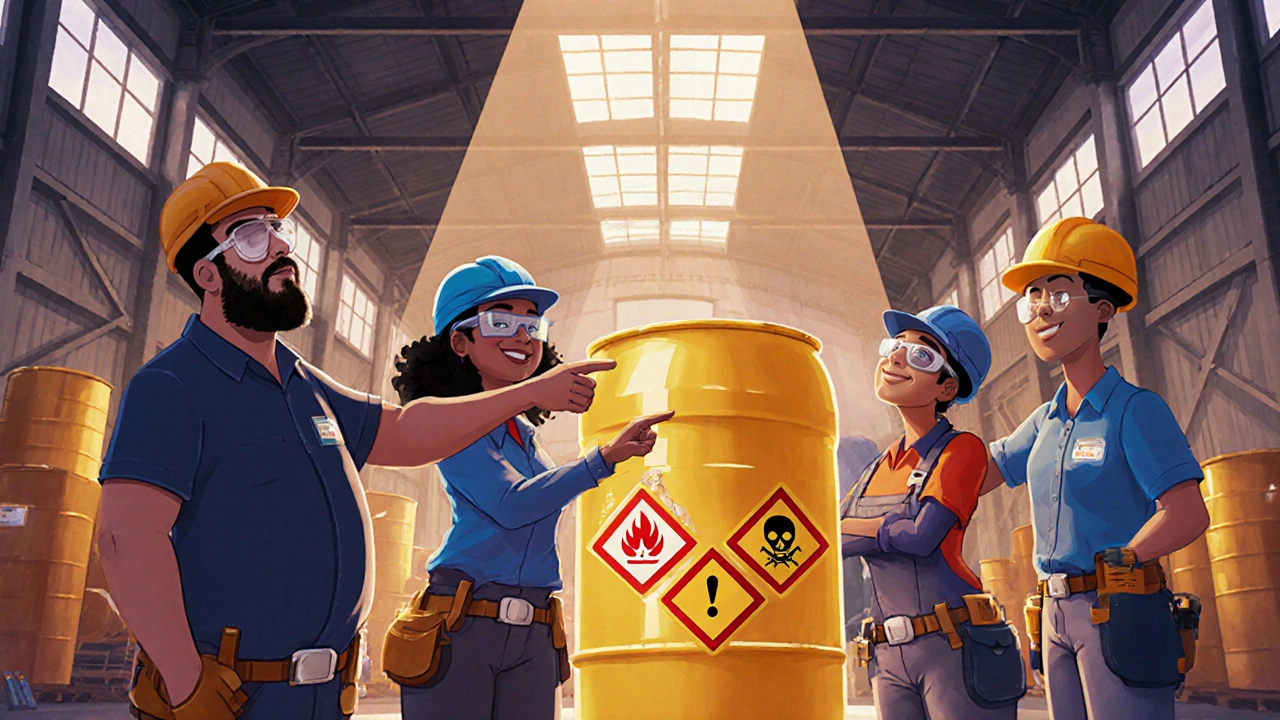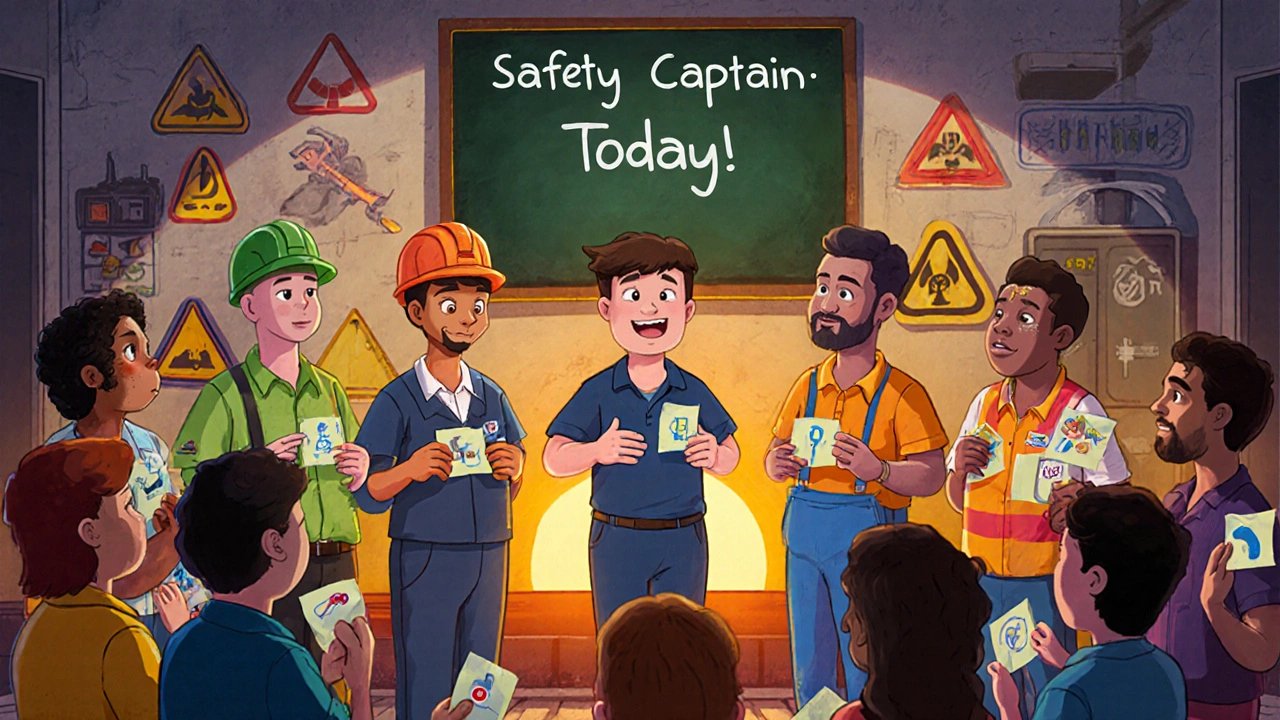Safety Training and Hazard Communication for Workplaces: What You Need to Know
 May, 12 2025
May, 12 2025
Every year, over 2.8 million nonfatal workplace injuries happen in the U.S. alone. Many of them aren’t accidents-they’re preventable. The biggest gap? Workers don’t know what they’re up against. Safety training and hazard communication aren’t just paperwork. They’re the difference between going home at the end of the day and ending up in the ER.
Why Safety Training Isn’t Optional
Some companies treat safety training like a box to check. They run a 20-minute video once a year and call it done. That’s not training. That’s negligence.
Real safety training teaches people how to recognize danger before it hits. It’s not about memorizing rules-it’s about building instinct. A worker who knows the signs of a leaking chemical container won’t wait for a supervisor to notice. They’ll shut it down. A machine operator who’s been trained on lockout/tagout procedures won’t reach into a running belt just to clear a jam.
The U.S. Occupational Safety and Health Administration (OSHA) requires employers to provide training that’s understandable and in the language workers speak. That means if half your team speaks Spanish, your training materials can’t be in English only. Simple. Non-negotiable.
Hazard Communication: The Language of Danger
Hazard communication isn’t just about labels. It’s about making sure everyone-regardless of literacy level, language, or experience-knows what’s dangerous and how to stay safe.
The Globally Harmonized System (GHS) sets the standard for hazard labels and safety data sheets (SDS). Every chemical container you handle should have:
- A product identifier (name or code)
- A signal word: “Danger” or “Warning”
- A hazard statement (e.g., “Causes severe skin burns”)
- A precautionary statement (e.g., “Wear gloves and eye protection”)
- A pictogram: a red diamond with a symbol inside (flame, skull, exclamation mark)
These aren’t decorations. They’re visual shortcuts. Someone who can’t read English can still understand a flame pictogram. That’s the power of standardization.
And don’t forget the Safety Data Sheets. These aren’t files you stash in a drawer. They’re living documents. Every employee who handles chemicals must know where to find them-and how to read them. A 2023 OSHA inspection found that 42% of workplaces failed because workers couldn’t locate an SDS within 30 seconds. That’s not just a violation. It’s a death sentence waiting to happen.
Training That Actually Sticks
People forget lectures. They remember stories. They remember what they felt.
Instead of reading slides about confined space entry, bring workers into a mock tank. Let them feel the heat, the tight space, the panic when the air monitor beeps. Make them practice rescue procedures with real gear. That’s retention.
Use real incidents from your own facility. Not the ones from 2012. The one last month when a forklift nearly hit a pedestrian because no one was using the horn. Talk about it. Ask: “What would you do differently?”
Training should be ongoing, not annual. New hires need orientation within their first shift. Seasoned workers need refreshers after a near-miss. If someone gets hurt, that’s not the end of the story-it’s the start of a new training module.

Who’s Responsible?
It’s easy to blame the worker. “They didn’t follow the rule.” But rules only work if they’re clear, accessible, and supported.
Employers must provide:
- Training materials in the right language
- Access to SDS for every chemical on site
- Proper PPE-and make sure it fits
- Time to learn, not just clock in
Supervisors aren’t just managers-they’re safety coaches. If they walk past a spill and say nothing, workers learn that safety isn’t a priority. If they stop and fix it, workers learn that safety is part of the job.
Workers also have a role. They must speak up. If a label is torn, if a vent is blocked, if a training video skips the part about emergency showers-say something. No one gets punished for asking questions. If they do, that’s a bigger problem than the hazard.
Common Mistakes That Cost Lives
Here’s what goes wrong in most workplaces:
- Using outdated SDS versions-chemical formulas change. Labels don’t always update.
- Assuming “everyone knows” how to use a fire extinguisher. Most people haven’t touched one since high school.
- Ignoring ergonomic risks. Carpal tunnel and back injuries are the #1 cause of lost workdays-not falls or electrocutions.
- Training only in English. In Arizona, nearly 30% of the workforce speaks a language other than English at home.
- Not documenting training. OSHA doesn’t ask if you trained people. They ask: “Show me the sign-in sheet.”
One company in Phoenix lost $180,000 in fines last year because they couldn’t prove they trained their warehouse staff on handling ammonia. The workers had been trained-just not documented. That’s not an accident. That’s a management failure.

What Good Looks Like
At a manufacturing plant in Tempe, they replaced annual training with monthly 10-minute safety huddles. Each huddle focused on one hazard: slippery floors, noisy equipment, lifting techniques. Workers rotated as “Safety Captain” each week. They picked the topic. They shared a story. They asked for feedback.
Within six months, near-miss reports went up by 67%. Injuries dropped by 41%. Why? Because people started paying attention. They weren’t just listening-they were involved.
Another company printed pictograms on sticky notes and put them on every machine. “This button stops the blade.” “This valve releases pressure.” No reading required. Workers who had never been to high school could now operate equipment safely.
Good safety doesn’t cost more. It just costs better.
Next Steps: Start Today
Here’s what you can do right now:
- Walk your facility. Find one unlabeled container. Label it today.
- Find your most recent SDS for a chemical you use. Is it accessible? Can someone find it in under 15 seconds?
- Ask three workers: “What’s the one thing you’re scared of at work?” Listen. Don’t fix it yet. Just listen.
- Check your training records. Are they signed? Dated? In the right language?
- Start a 5-minute safety talk at your next team meeting. No slides. Just a real story.
Safety isn’t a program. It’s a habit. And habits start with one small, consistent action.
Is hazard communication training required by law?
Yes. Under OSHA’s Hazard Communication Standard (29 CFR 1910.1200), all employers with hazardous chemicals in the workplace must train employees on how to read labels and Safety Data Sheets. This applies to every industry-from warehouses to hospitals to construction sites. Failure to comply can result in fines up to $16,550 per violation.
Do I need to train temporary workers?
Absolutely. Both the staffing agency and the host employer share responsibility. The host employer must provide site-specific training-like how to respond to a chemical spill in their building. The agency must provide general hazard training. If you’re using temps, you’re still liable if they get hurt because they didn’t know what they were handling.
What if my employees don’t speak English?
OSHA requires training in a language and vocabulary workers understand. If you have workers who speak Spanish, Mandarin, or Arabic, your safety materials must be available in those languages. Use pictograms, videos, and hands-on demos to bridge language gaps. Don’t rely on translation apps during training-use professional, verified materials.
How often should safety training be repeated?
There’s no single rule, but OSHA recommends annual refreshers for most hazards. More frequent training is needed after incidents, when new equipment is introduced, or when changes are made to procedures. If you’ve had a near-miss, that’s your cue to retrain-not just to document it.
Can I use online videos for safety training?
Online videos can be part of training, but they’re not enough on their own. Workers need to ask questions, practice procedures, and demonstrate understanding. A video might show how to use a fire extinguisher-but only hands-on practice with a real unit will prove they can do it under pressure. Use videos as a supplement, not the whole program.
Mongezi Mkhwanazi
October 31, 2025 AT 14:17Let’s be real-most companies treat safety training like a tax write-off, not a lifeline. They print a poster, slap it on the wall, and call it ‘compliance.’ Meanwhile, workers are left guessing whether that red diamond means ‘handle with care’ or ‘do not touch under penalty of death.’ And don’t get me started on the SDS folders-locked in a cabinet behind the boss’s office, buried under last year’s holiday party photos. If you can’t find it in 30 seconds, you’re not failing a compliance check-you’re failing humanity. And yet, somehow, the same people who won’t spend $500 on translated materials will spend $50,000 on a ‘wellness program’ that includes free yoga mats and kale smoothies. Priorities, people.
Mark Nitka
October 31, 2025 AT 23:28Actually, this is spot-on. I’ve seen too many shops where the only ‘training’ is a PowerPoint that skips every third slide because the IT guy didn’t update the projector. Real safety isn’t about checking boxes-it’s about culture. At my plant, we started having workers lead 5-minute huddles on near-misses. No managers. No slides. Just people talking about what almost killed them. Within months, people started reporting things they’d never mentioned before-like a cracked valve they were afraid to say anything about. That’s the power of trust. And it costs nothing.
Kelley Nelson
November 1, 2025 AT 03:27While I find the general sentiment of this piece commendable, I must express my profound concern regarding the lack of scholarly citations and the absence of peer-reviewed data supporting the assertion that ‘training that actually sticks’ correlates directly with reduced injury rates. The anecdotal reference to Tempe’s manufacturing plant, while emotionally compelling, lacks statistical rigor. Moreover, the casual dismissal of digital training modalities as ‘not enough’ is regressive in an era where microlearning platforms have demonstrated up to a 47% improvement in knowledge retention, according to the Journal of Occupational Health & Safety (2022). I urge a more evidence-based approach to workplace safety discourse.
Aryan Gupta
November 2, 2025 AT 18:57They’re lying to you. OSHA doesn’t care about your ‘hazard communication.’ They care about fines. That’s why they demand sign-in sheets-because paper trails are easier to fake than real safety. And don’t believe the GHS nonsense-it’s a global scam designed to make chemical companies richer. Pictograms? Please. I worked in a plant where the ‘danger’ symbol was used on a bottle of dish soap. Workers stopped trusting labels entirely. Now they ignore everything. And the ‘safety captains’? They’re just the boss’s pet who gets a free lunch. Meanwhile, the real hazards-the ones nobody talks about-are the ones that come from management cutting corners on maintenance. That’s the truth. And if you think training fixes that, you’re the one who needs to be trained.
Fredda Freyer
November 3, 2025 AT 19:55I’ve spent 18 years in industrial safety, and this is one of the clearest summaries I’ve seen. The key isn’t just training-it’s psychological safety. People won’t speak up if they think they’ll be blamed. I once worked with a team where the foreman would yell at anyone who reported a near-miss. Within a year, injuries tripled-not because hazards increased, but because people stopped talking. The moment we started rewarding reports, not punishing them, the culture flipped. You don’t need fancy tech. You need to listen. And then, when someone says, ‘I’m scared,’ you don’t say, ‘That’s not a big deal.’ You say, ‘Thank you. Let’s fix this.’ That’s the only training that lasts.
Gareth Hobbs
November 4, 2025 AT 12:51Blimey, this is what happens when you let Americans run things. You’ve got these ‘safety huddles’ and ‘sticky notes’ like we’re in some kindergarten. Back in my day, you learned by doing-or by getting your fingers crushed and learning the hard way. Now everyone wants a hand-holding, rainbow-colored, translation-app version of safety. Pictograms? For crying out loud, if you can’t read a label, maybe you shouldn’t be handling chemicals. And don’t get me started on the ‘temporary workers’ nonsense-why are we letting agencies off the hook? The host employer? The agency? Who’s actually paying the bills? It’s all a bureaucratic circus. And don’t even mention the ‘language’ thing-half the workforce in this country can barely speak English, let alone understand a SDS. Maybe the answer isn’t more training… maybe it’s fewer people.
Zelda Breach
November 6, 2025 AT 03:39Oh, here we go. Another feel-good article from the safety-industrial complex. Let me guess: the author works for a consulting firm that sells ‘interactive training modules’ for $15,000 a pop. Real safety? It’s about enforcement. Not ‘stories.’ Not ‘huddles.’ Not sticky notes. It’s about consequences. If someone bypasses a lockout, they get fired. Not a ‘refresher.’ Not a ‘conversation.’ Fired. And if your training isn’t in English? Then your workers shouldn’t be handling hazardous materials. This isn’t daycare. It’s a factory. And if you can’t follow basic instructions? You don’t get a participation trophy-you get replaced. This whole ‘inclusive’ nonsense is why American workplaces are so weak.
Alan Crierie
November 7, 2025 AT 05:47This is brilliant. I’ve seen too many workplaces where safety is treated like a chore. I love the idea of sticky-note pictograms-simple, visual, universal. And the ‘Safety Captain’ rotation? Genius. It gives people ownership. I once worked in a warehouse where we started a ‘Safety Story Friday’-everyone shared one thing they were grateful for or worried about. No pressure. No judgment. Just honesty. Within three months, people started bringing in their own ideas-like using colored tape to mark safe walking paths. It wasn’t mandated. It was community. That’s what safety should feel like: not fear, not compliance… but care. 🙌
Nicholas Zeitler
November 9, 2025 AT 00:14One thing no one talks about: PPE that doesn’t fit. I’ve seen guys in 3XL hard hats, gloves that are two sizes too small, and respirators that leak because they didn’t get fitted properly. You can have the best training in the world, but if your mask is falling off, you’re not safe-you’re just lucky. And don’t forget: training isn’t one day. It’s a habit. I make my team do a 2-minute safety check before every shift. One person picks one thing: ‘Did we check the guard on the saw?’ ‘Is the spill kit full?’ ‘Is the emergency shower clear?’ It takes 120 seconds. But it builds muscle memory. And when something goes wrong? They don’t freeze. They act. That’s training.
Teja kumar Baliga
November 10, 2025 AT 04:19Love this. In India, we call this 'jugaad safety'-fixing things with what you have. My uncle worked in a textile mill where they painted hazard symbols on old tin cans and hung them next to machines. No SDS? They made a simple audio guide on a phone. Workers pressed play. No reading needed. Safety isn’t about expensive tools. It’s about heart. And listening. If you treat people like humans, they’ll protect each other.